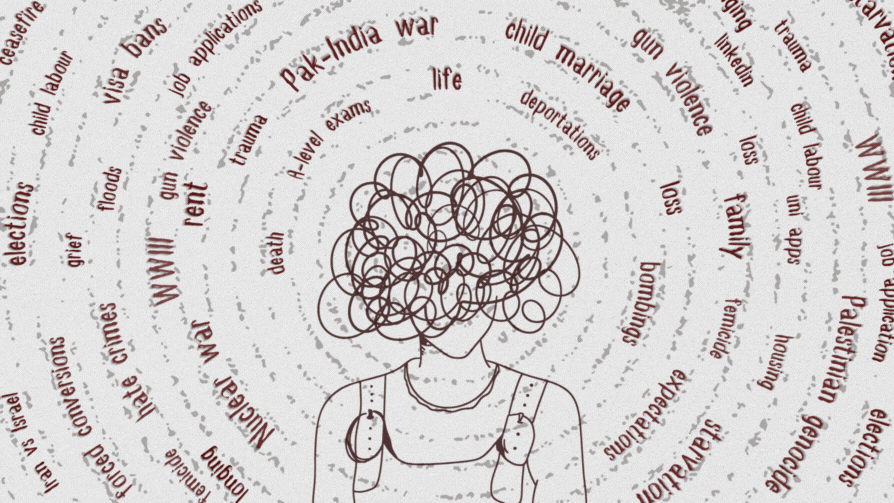SlutWalks and short skirts: When (and how) a woman’s modesty became linked to her clothes
The policing of women begins insidiously, cloaked casually and convincingly in good intentions. Maybe the first time it happens, a mother will do it to her own daughter.
At 15, I came home to stern words. “You must learn to carry yourself better,” my mother said to me. “There is no need to make a spectacle of yourself and attract unwarranted attention.” I was nonplussed. I had been out with a close friend, both of us atypical to our gender, misfits in the teen-girl-interested-in-boys milieu, ergo invisible. It turned out that the husband of the woman who cleaned our house had seen my friend M and I doubled over in laughter on the corner of the street and sent word about our immodesty. It is the first time I remember challenging my mother calmly, “A man who beats his wife thinks I should not laugh on the street?”
I watched my mother’s face change in an instant. Horrified at her own conditioned reaction, she immediately acquiesced and apologised. It was a turning point in our relationship. But I have carried a quiet rage ever since.
Concepts of modesty
Discussions on modesty have degenerated into frustratingly simplistic rants about what women wear. There are shrill cries that the Burqa versus the Bikini is symbolic of the great Clash of Civilizations. But a rudimentary Google search about modesty throws up mostly western Christian websites, blogs and thinkpieces all tomtomming the glories of modesty. (The Bible, Genesis 3:7 claims dibs on the first people to realise they needed “loin coverings”.) Today, the traditionalists of Islam and Hinduism seem to agree that the natural shape of women’s bodies, whether their faces, ankles, wrists, breasts, buttocks, is immodest. Far from clashing, the civilisations concur, if only in this one regard – the policing of women.
In theory, modesty as part of a social contract is not without its merits. From the Latin modestus, to keep within measure, modesty was offered as key to Cicero’s “golden mean of living… the parent of many other virtues”. In this quote from the Catechism of the Catholic Church 2521-2522, modesty is presented as an “integral part of temperance”, a guide to “how one looks at others and behaves toward them in conformity with the dignity of persons and their solidarity. Modesty is decency”. It was interpreted to dissuade any displays of excess, even more traditionally male demonstrations of power or wealth. It’s what any civilised society would aspire to.
Yet this quick encyclopedia timeline of the evolution in concepts of modesty reveals its slow but steady skew towards a focus on women’s wardrobes. It is important to remember that women’s clothes and women’s rights are linked in far more important ways than their mere ability to arouse a man. The formation of The Rational Dress Society sought to facilitate the increased participation of women in public life. The Society advocated women wear no more than three kilograms of underwear for ease and agility. Thus unburdened, they then shocked society by demanding (and winning) the right to vote and riding bicycles.
More than a century later, some ultra-orthodox religious men still find women on bicycles “too provocative”. So perhaps it is worth trying, for a minute, to understand where these excitable men are coming from.
In his book The Evolution of Modesty, Havelock Ellis, a 19th century physician who studied sexuality suggests first that modesty is “an instinctive fear to concealment usually centering around the sexual processes”.
Okay.
He then says that modesty is “more peculiarly feminine, the woman who is lacking in this kind of fear is lacking also in sexual attractiveness to the normal and average man”.
Fine. We are hoping for the above-average man anyway.
But then Ellis makes the case that “the sexual impulse in women is fettered by an inhibition which has to be conquered”, stressing that the “immense importance of feminine modesty in creating masculine passion must be fairly obvious”.
I would say, ladies, please go ahead and make a fairly obvious rude gesture to that.
Because now we are utterly confused. Is sartorial modesty meant to protect men from being turned on by women? Or is it a tool to render women into veiled coquettes to turn men on?
Navigating Indian cultures
The answer may lie in the link between modesty culture and rape culture.
American Christian feminist and champion of the rights of women to serve as ministers and in leadership roles in the church, Jory Micah, recounts her early problems with the enforcement of a dress code in Bible school: “I realise how much it harmed my heart to have many peers and ‘mentors’ looking me up and down, examining my body, counting how many curves were showing…”
She is quite clear that “grown men church leaders should never be policing girls’ and women’s clothing or bodies. It’s creepy and none of their business”. We all cringe at religious propaganda that makes associations between women who seem sexually liberated with “chewed gum” and “unwrapped sweeties”. But this emphasis placed on supposed purity and virginity is not only degrading but harms survivors of sexual assault, creating room for victim blaming.
India’s Minister of Culture and Tourism Mahesh Sharma recently tried to clarify his stance on “revealing clothing” in a tourist advisory, saying he was just “concerned” for the safety of women. No Indian woman was surprised he placed the onus of women’s sexual safety on her choice of clothes, the time of day she went out in public, her ability to read the apparently homogeneous (and misogynous) Indian culture. A culture where courts have had to define what it is to outrage the modesty of a woman.
The counterpoint to our minister’s helpful advice is the freedom women feel when they travel to countries not obsessed with women’s modesty. You can drink a glass of wine, smoke a cigarette, wear a skirt, sit alone in a café, travel at night with no fear of incident. We met a Pakistani farm labourer on a train in Italy and he remarked on the differences between South Asia and Europe. “Here, women have a lot of freedom,” he said, looking at me and my daughters meaningfully. “A mother may not even know where her daughter is.” “So much more relaxing for the men, no? Knowing that other men will respect her?” I shot back. He grudgingly agreed.
The trouble is we are not always sure where we stand in this discussion on modesty of clothing and deportment. Our big cities organise SlutWalks to protest victim-blaming while in rural areas women are routinely stripped to shame them. An Indian girl in a bikini on a local beach will cause scores of desi men to whip out phone cameras (or worse) while a ghoonghat or niqab will elicit audible tut-tutting at an upscale restaurant. Every day in urban India we dress for our culture and must navigate several different Indian cultures all united by male entitlement.
We seem to have our work cut out for us. First, we must acknowledge that any enforcement of women’s modesty is proof of the failure of that culture rather than its greatness. And second, we must remember to laugh out loud more often in public, if nothing else then at patriarchy’s inability to police itself.
This article originally appeared on Scroll.in and has been reproduced with permission.













Comments